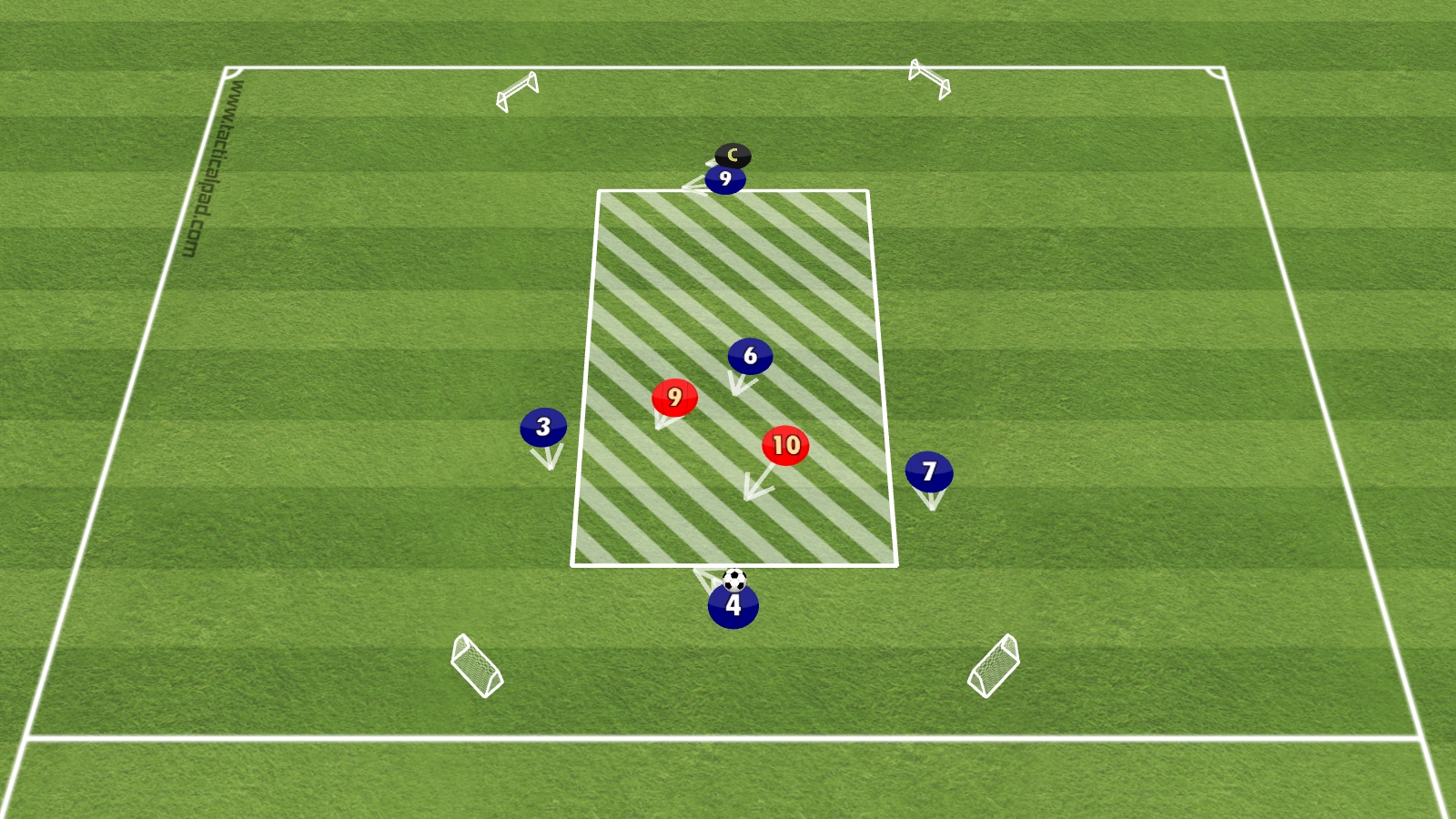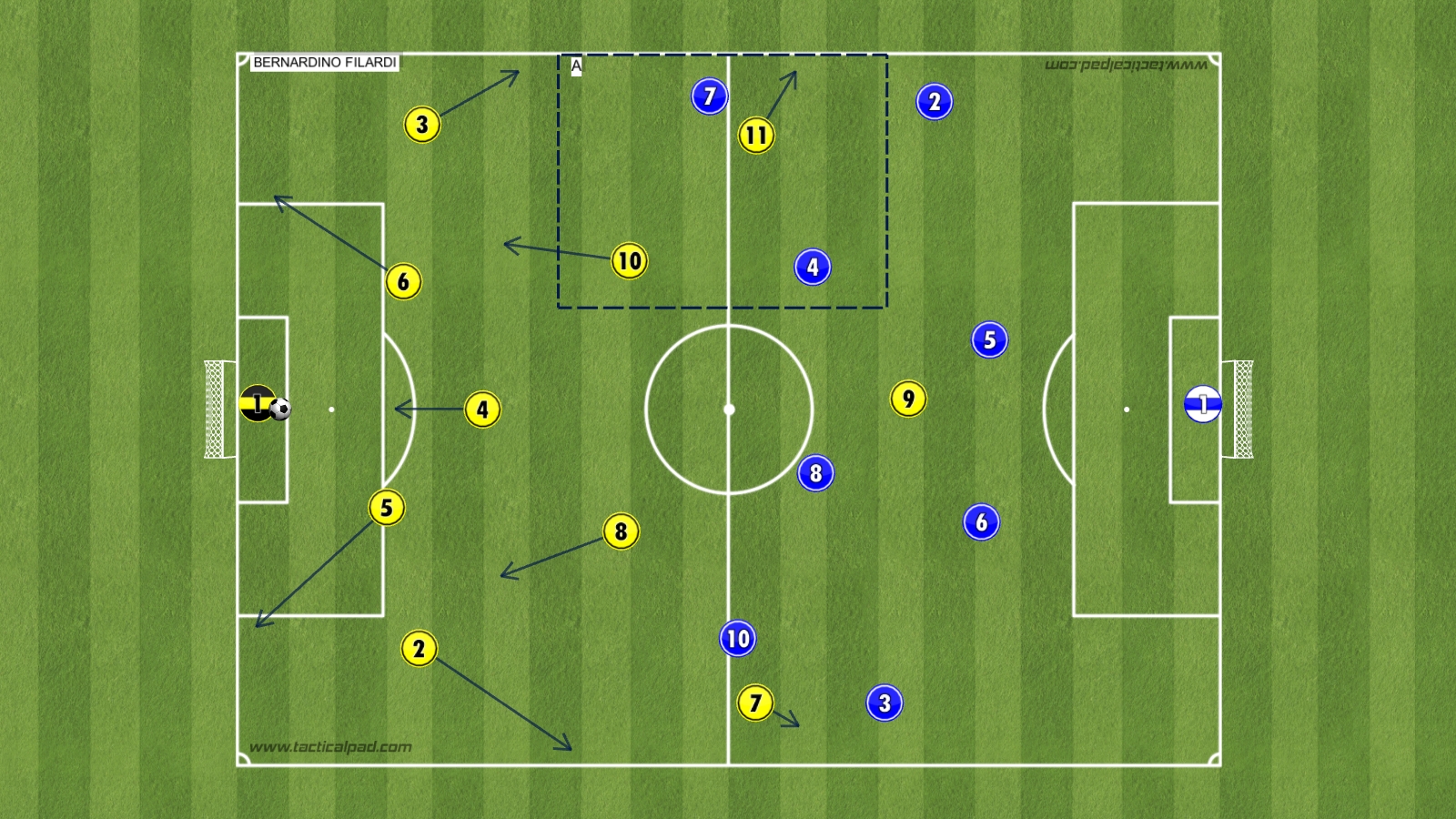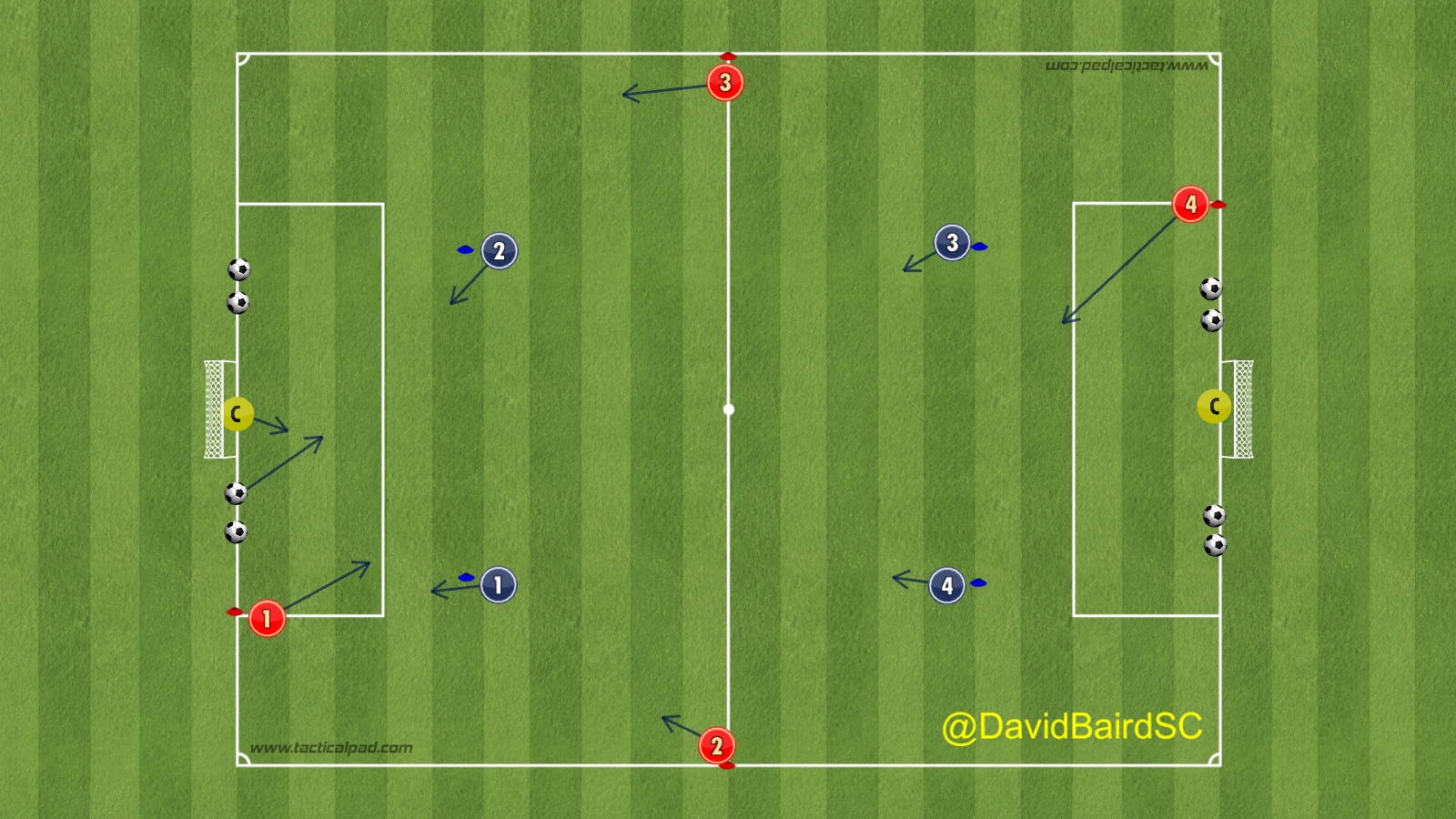PARTITA A TEMA_SMARCAMENTO ALLE
PARTITA A TEMA : SMARCAMENTO ALLE SPALLE SECONDA LINEA DI PRESSIONE
In questa esercitazione, in un campo delimitato come nel video, abbiamo una partita tra due squadre che giocano un 8vs10.
Si parte sempre con la squadra blu in possesso palla (squadra in inferiorità numerica) che ha l'obiettivo di cercare un compagno all'interno del Settore B (zona di smarcamento alle spalle del centrocampo avversario) , il quale a sua volta dovrà servire un esterno nel Settore A che a sua volta andrà al cross in area di rigore per la conclujsione dei compagni contrastati dalla linea difensiva avversaria.
In caso di riconquista della palla la squadra avversaria dovrà cercare di segnare entro il tempo massimo di 10 secondi la rete in una delle due porticine.
VARIANTE : Se la squadra in inferiorità numerica perde palla e la riconquista entro il tempo massimo di 5 secondi, un avversario (quello che perde palla o che sbaglia il passaggio) dovrà abbandonare il campo per il tempo stabilito dal Mister ed andrà ad eseguire un esercizio a secco.
December 23, 2024
Learning in the Game
There is always a first time for everything, to question yourself, to learn, to grow, to move away from a safe haven, to overcome limits through knowledge, to do all these things together in the time of a choice. However, every time you really ask yourself about learning in the game of football, everything changes, it is a first time different from all the others, because learning in the game of football is a universe in which you can travel endlessly, without ever feeling like you have reached a goal. A journey into emotions and complexity. To approach the game in its essence, to touch its atom, you have to get lost and go there where no compass can be able to "correct" the steps following a score. We have always been taught to be tightrope walkers who, on a tightrope, never look down, do not accept the fear of failure, ready to set the goal ahead as the only imperative. without asking questions. Fiercely, we identified the objective with victory, with quantity, often forgetting the importance of the path and the quality in the obvious "it has always been done this way". A rigid linearity that hides within itself that undergrowth of illusions which have slowly transformed the certainties of a few into an untouchable culture for many. Yet it doesn't add up, there is something that the game of football in all its manifestations promptly tries to tell us, when like smoke it flows through the fingers and refuses to be controlled, grasped and understood. And so, it happens that something doesn't go right and that, in the cracks of a fleeting thought, the possibility of discovery, of evolution, of comparison, of a horizon that transforms the tightrope walker into a diver creeps in. A dive into uncertainty, far from protagonism, a dive preceded by a long walk on a tangled wire, with the head going up and down incessantly. Because if learning is born and grows through trial and error then it will always be considered as a seesaw that oscillates between what you feel on your skin and what vibrates in your stomach. Emotions and perceptions. My reflections do not start from the analysis of how much, over time, we have chosen to de-structure the game and in fact its complexity, but I would like to emphasize the question. Every time I observe one of my teams emerging freely from the chaos , whether in a simple development of progression, rather than in a duel or perhaps in an offensive transition in the open field in numerical superiority, is a wonderful first time that makes me reflect. In that mix of emotions and previous experiences that make learning an unconscious awareness with every gesture, choice, interpretation of the changing circumstance, which always creates a crossroads, I get lost. We create contexts in which the complex footballer system and the complex team system know how to move in entropy, in that disorder that leads to the emergent behaviors that will be the basis for the construction of the Game Model (through the Principles ). The created context (space - opposition - objectives) in turn determines the environment in which the systems attract each other, modifying the starting points and generating that self-organization which will be the distinctive feature of their be in the game. The resulting environment will in turn self-organize, stimulated by the systems involved (single-collective-observers), a self-echo self-organization that increases entropy and increasingly distances the possibility that some type of compass, even the most sophisticated one can predict the outcome of a development (with or without the ball, let alone during transitions).
3v3+3c MULTIPLE WORMHOLE


MULTIPLE
A beautiful demanding game where defenders have to execute different roles. The game starts with a cross by one team to his mates in the box, They have some seconds set by the coach to finish their attack. Then, the other side coach passes to the opponents. The opponents only start the run when the defenders are at the midfield line. Every defender gets asap to his gate. Forwards also must finish during the set time. Once they finish, one forward or 2 move to the sides waiting for their defenders to arrive and cross or short pass the ball, and start over.
December 21, 2024
USCITA IN AMPIEZZA, 2VS2 IN ZONA LATERALE
USCITA IN AMPIEZZA , 2vs2 IN ZONA LATERALE E TRANSIZIONE NEGATIVA
In questa esercitazione gli aspetti fondamentali, al di là della esercitazione stessa sono i seguenti :
• Forzatura dell’uscita bassa su un lato con conduzione di un centrale difensivo, successiva copertura preventiva dell’altro centrale difensivo ed abbassamento di un centrocampista lato opposto (quindi non tra i due difensori centrali ) : si attira la prima linea di pressione avversaria su un lato per poi cambiare gioco sulla parte opposta . Ciò comporta la successiva uscita di un centrocampista avversario sul portatore di palla ( il n. 8) con conseguente possibilità di liberare un nostro uomo alle spalle ;
• Nel 2vs2 in zona A o B si può notare come la disposizione “piatta” del terzino e dell’esterno (uno dentro ed uno fuori quasi in linea) obbiga l’esterno basso avversaro a dover fare la scelta di rompere o meno la linea difensiva ;
Tornando alla esercitazione abbiamo il giropalla come in video con obiettivo (dopo aver attirato la coppia di attaccanti su esterno e successivo cambio di fronte con utilizzo sia del centrocampista n. 8 che del jolly n. 4) di attivare un 2vs2 in uno dei due Settori A o B tra le coppie di esterni rosse e nere , per eseguire la conclusione in una delle due porte .
Nella terza parte del video si cerca un cambio di gioco attraverso il n. 4 che ha la funzione di jolly : infatti se la squadra rossa conquista palla attiverà una transizione in una situazione di 6vs5 (i due attaccanti 9-10 e le due coppie di esterni 2-7 e 3-11 che giocano contro la linea difensiva 2-5-6-3 ed il centrocampista 8) e con il n. 4 jolly che gioca con la squadra che esegue il contrattacco.
December 23, 2024
ESERCIZIO INTEGRATO_CAMBI DI DIREZIONE E
ESERCITAZIONE INTEGRATA : Cambi di direzione e 6vs4
I quattro difensori eseguono dei cambi di direzione in maniera veloce prima di andare a prendere posizione all'interno dello spazio delimitato , mentre altri sei elementi (attaccanti) eseguono una combinazione con palla (contemporaneamente a movimenti di "vai e torna") con sovrapposizione finale, andando a condurre palla nello spazio delimitato (il pallone da condurre viene indicato dal Mister). I sei attaccanti si posizioneranno con due sponde esterne e dovranno affrontare i difensori in una situazione di 6vs4 con l'obiettivo di uscire dallo spazio con una combinazione prestabilita ed andare a concludere a rete in maniera indisturbata.
December 23, 2024
ESERCIZIO 63….. 23.9.2017
ESERCIZIO PER ALLENARE LE TRANSIZIONI
In questa esercitazione abbiamo inizialmente due squadre composte da 7 elementi + 1 jolly che sono disposti come segue :
• Nella metà campo sinistra avremo un 5vs4 (5 blu contro 4 rossi) + 1 jolly , con i due esterni blu (2 e 3) che giocano oltre la linea laterale come sponde esterne .
• Nella metà campo destra avremo un 3vs2 (3 attaccanti rossi contro due difensori blu) che si svolge in forma analitica senza alcuna conclusione in porta (si cercano solamente i movimenti di marcamento e copertura da parte dei difensori) .
Nella metà campo sinistra la squadra blu dovrà cercare il gol ; in caso di gol l’azione riparte sempre dalla squadra blu che attacca la linea difensiva rossa, mentre in caso di riconquista da parte dei rossi, questa viene giocata immediatamente sui 3 compagni attaccanti nella metà campo opposta per giocare contro la squadra rossa : alla riconquista infatti i due terzini rossi si sposteranno velocemente al di fuori della linea laterale della metà campo opposta ed insieme a questi anche il jolly n. 8 a giocare un nuovo 5vs4 + 1 jolly nella metà campo opposta, mentre i terzini blu n. 2 e 3 rientreranno velocemente a riprendere la posizione e ricomporre una linea difensiva con i compagni blu n. 5 e 6. Pertanto dall’altra parte avremo la situazione ribaltata con u8n 3vs2 degli attaccanti blu n. 7,9,11 contro i difensori centrali n. 5 e 6.
Si continua in questo m0odo per il tempo stabilito dal Mister.
Vince la squadra che ha eseguito il numero maggiore di transizioni dopo riconquista.
December 23, 2024



